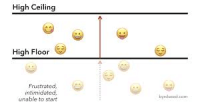
I first heard of low floor high ceiling math tasks on a K-12 math blog. It’s an interesting concept; find a task that everyone in the class can start and that adequately challenges all students. To say the least, I was skeptical, so I tried it out.
My first attempt was with my twin granddaughters, Janna and Ada. Ada has autism and is severely cognitively delayed. Janna is moderately cognitively delayed. I chose a three-act task from Jon Orr’s site and we did it. I was amazed. Both girls were able to participate in the task. At one point they were asked to say what they noticed. Janna, who is verbal, was able to identify things she noticed. Ada does not communicate well, but she was able to point out some things that Janna had not noticed. Both girls were able to come up with a good question that should be answered. This was pretty interesting – an educational task that both of these girls could do at their own level. How will this work with a different mix?
My second attempt was with Janna and another granddaughter, Emily. Emily is neurotypical and performs about two grade levels above Janna. I ran another task from Jon’s site with these two girls. The same results – both girls could get started on their own. They could work together understanding the task and then each could complete the task at her level. Janna used counters and Emily used multiplication. This is the perfect kind of task.
Can I create such tasks for my college classes? Better yet, can I create a task that I can use in multiple classes for multiple levels? I think the answer is yes. I have a modeling task that was originally designed for differential equations, my highest class. But it seemed like a task that any level of student could get started with and by changing the questions, could be used at multiple levels.
I gave it a try. I adjusted the questions for two different classes, calculus III and Math Explorations. It was a success in both classes and I am looking forward to using the activity in differential equations in the spring. I am certain that I can adjust this activity to work in any class I teach and that every student will be able to understand and start the activity and will be able to make progress and be challenged. My next challenge is to find/create more of these.

